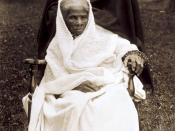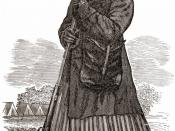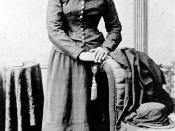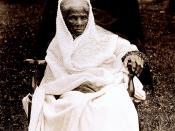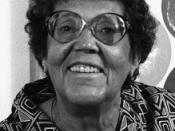Born on two different sides of the world, Catlett and Kollwitz have become greatly known artist everywhere. Printmaking has been an art form that both Catlett and Kollwitz have used to express their art to the audience. The definition of printmaking is the artistic design and manufacture of prints, such as woodcuts or silk-screens. Some examples of these work is Harriet by Elizabeth Catlett and Outbreak by Kathe Kollwitz. Both artists have creative pieces of work in many different ways but also similar ways.
Printmaking is a very difficult way of creating art but both artists seem to do that very well, but both in their own way. In Elizabeth CatlettÃÂs Harriet she uses linocut. Other techniques that she uses are lithographs, serigraphs, and monoprints. Etching, aquatint, and soft ground were the techniques that Kollwitz used to capture the print Outbreak.
Another, thing that both these prints have in common is the artists betray two strong women in their work of Harriet and Outbreak.
In KollwitzÃÂs Outbreak, which comes from a series called PeasantsÃÂ War, it portrays a Black woman, named Anne, who is leading the tortured laborers into battle against their oppressors. But who was Anne? Kollwitz says, ÃÂI continued to represent ÃÂto seek to get out of me- to search for the image of women revolutionary. Black Anne supplied me, at last, with the historical personage for this purpose. I used my own likeness for the preliminary drawings for Black Anne herself.ÃÂ The peasants in the background she says are the depriving people that didnÃÂt have the use of free meadows and woodland, which denied them of their established right. So the strong women Anne and her followers are going to war against their lords and the repressive Roman Catholic Church, a large landowner, to take back their civil rights and their freedom.
Just like KollwitzÃÂs work CatlettÃÂs portrays a heroic woman Harriet Tubman, with her followers in her command. Harriet was a fifteen series of linoleum cuts called The Negro Women. Catlett indentified each of her subjects by saying, "I am the Negro woman. I have always worked hard in America. . . . In the Fields. . . . In other folks' homes. . . . I have given the world my songs. In Sojourner Truth I fought for the rights of women as well as Negroes. In Harriet Tubman I helped hundreds to freedom. In Phillis Wheatley I proved intellectual equality in the midst of slavery. My role has been important in the struggle to organize the unorganized. I have studied in ever increasing numbers. My reward has been bars between me and the rest of the land. I have special reservations. . . . Special houses. . . . And a special fear for my loved ones. My right is a future of equality with other Americans" She composed reinforced meanings to all of her work. Harriet Tubman guided hundreds of slaves to freedom and inspired many others. She expresses this in her own version of Harriet.
Also, both artists had many struggles when growing up, but at the same time the struggles were different for Kollwitz and Catlett. Catlett was born and raised in Washington DC, in a middle class family. Around the age of 13, Catlett chose to become an artist, and was supported by her mother. Her inspiration came from many places, such as the Civil Rights Movement and the struggles of Black Power, such as the Harlem Renaissance, in the United States. Her sistersÃÂ and brothersÃÂ struggles, the police brutality that was directed at blacks and the demanding womenÃÂs role in movements for the black liberation inspired her work as well. Catlett also seemed to be inspired by the Kollwitz she described Kollwitz work as, ÃÂpowerfully expressionistic images of women, their large, strong hands connoting their working-class status.ÃÂKollwitz was born in East Prussia, where her father encouraged her to draw at the age of 14. Some influences that inspired her work came from the social conditions in Germany during the late 19th and early 20th century. When moving to a poor city of, in Berlin, it lead to develop her strong social consciousness, which could be characterized as "critical humanitarianism", separated her from Modernist artists who wanted to minimize the importance of subject matter, and such pioneering Expressionist groups. During in time in living here Kollwitz witnessed daily the pain of distressed families and the troubles of the working class women, making her work that much more personal.
ÃÂTo present black people in their beauty and dignity for ourselves and others to understand and enjoy,ÃÂ Catlett said that was her purpose of her art. In Outbreak and Harriet I think that they both present strong black women in a powerful, beauty, and dignified way. These women went through struggles and hardships to get to the art that people look at and are inspired. They take pride in their work, and that pride comes with pain and patience. But for all the hard work they both have done Kollwitz and Catlett are two women that represent how strong women can really be, and will forever inspire women to be strong.
Reference pagehttp://www.fredmartin.net/Art-Histories/Kollwitz.pdfhttp://www.ask.com/bar?q=Kathe+Kollwitz+influences&page=1&qsrc=19&ab=0&u=http%3A%2F%2Fwww.kirjasto.sci.fi%2Fkollwitz.htmhttp://www.ask.com/bar?q=What+was+the+meaning+of+Elizabeth+Catlett+Harriet&page=1&qsrc=19&ab=1&u=http%3A%2F%2Fwww.tfaoi.org%2Faa%2F6aa%2F6aa198a.htm
